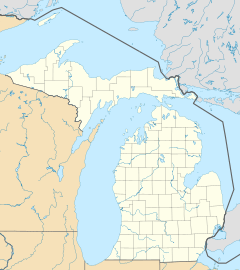Riley Township, St. Clair County, Michigan facts for kids
Quick facts for kids
Riley Township, Michigan
|
|
|---|---|

Location within St. Clair County
|
|
| Country | United States |
| State | Michigan |
| County | St. Clair |
| Area | |
| • Total | 38.3 sq mi (99.2 km2) |
| • Land | 38.3 sq mi (99.1 km2) |
| • Water | 0.0 sq mi (0.0 km2) |
| Elevation | 784 ft (239 m) |
| Population
(2020)
|
|
| • Total | 3,199 |
| • Density | 83.52/sq mi (32.248/km2) |
| Time zone | UTC-5 (Eastern (EST)) |
| • Summer (DST) | UTC-4 (EDT) |
| ZIP code(s) |
48041
|
| Area code(s) | 810 |
| FIPS code | 26-68620 |
| GNIS feature ID | 1626982 |
Riley Township is a community located in St. Clair County, Michigan, in the United States. It is a type of local government area called a civil township. In 2020, about 3,199 people lived there, according to the 2020 Census.
Contents
Exploring Riley Township's Communities
Riley Township is home to a few smaller communities. Each has its own story and place within the township.
Doyle: A Historic Railroad Stop
- Doyle was once a busy spot because of the Port Huron and Northwestern Railroad. It was located where the railroad crossed Riley Center Road. Doyle even had its own post office for many years, from 1885 until 1913.
Riley Center: The Heart of the Township
- Riley Center is a small, unincorporated community right in the middle of Riley Township. This is where the township hall is located, which is like the main office for the local government. It's about 5 miles northwest of Memphis, a larger nearby city.
Memphis: A Neighboring City
- Memphis is a city that sits on the southern edge of Riley Township. Even though it's right next door and uses the same ZIP code (48041) as Riley Township, Memphis is its own separate city with its own government.
Emmett: Close to the Corner
- The village of Emmett is another community located very close to Riley Township, right next to its northeast corner.
The Story of Riley Township
Riley Township has a rich history that dates back many years.
How Riley Township Got Its Name
Riley Township was officially formed in 1841. It was named after John Riley. John was part Chippewa, and his father had bought land in the area in 1836. John was given a special lease on this land for a very small fee each year. A post office also served the area from June 1867 until September 1933.
Understanding Riley Township's Geography
Riley Township is mostly land, with very little water.
Land and Water Area
According to the United States Census Bureau, Riley Township covers a total area of 38.3 square miles (which is about 99.2 square kilometers). Almost all of this area, 38.3 square miles (99.1 square kilometers), is land. Only a tiny part, about 0.04 square miles (0.1 square kilometers), is water.
Who Lives in Riley Township?
The people who live in Riley Township make up its community. Here's a look at the population based on information from the year 2000.
Population Overview
In 2000, there were 3,046 people living in Riley Township. These people lived in 1,020 households, and 854 of these were families. The population density was about 79.6 people per square mile.
Diversity in the Community
Most of the people living in the township in 2000 were White (97.50%). There were also smaller percentages of African American (0.49%), Native American (0.10%), and Asian (0.16%) residents. Some people identified as being from other races (0.39%) or from two or more races (1.35%). About 1.58% of the population identified as Hispanic or Latino.
Households and Families
Out of the 1,020 households, 42.5% had children under 18 living with them. Most households (75.1%) were married couples living together. A smaller number (5.4%) were female householders without a husband present. About 16.2% were not families.
Age Groups in the Township
The population in Riley Township is spread across different age groups.
- About 29.2% of the people were under 18 years old.
- 6.2% were between 18 and 24.
- 34.5% were between 25 and 44.
- 22.1% were between 45 and 64.
- 8.0% were 65 years old or older.
The average age in the township was 35 years.
Income and Economy
In 2000, the average income for a household in Riley Township was $63,790. For families, the average income was $65,919. The average income per person in the township was $22,381. A small percentage of families (2.6%) and people (3.4%) lived below the poverty line.
Important Buildings and Structures
Riley Township has some interesting historic structures.
Masters Road / Belle River Bridge
The Masters Road / Belle River Bridge was built in the 1930s. This bridge is a good example of the types of projects that were built during the Great Depression to help people find work. It was constructed by J.H. Baker and Sons and cost $9,391 to build.
See also
 In Spanish: Municipio de Riley (condado de St. Clair) para niños
In Spanish: Municipio de Riley (condado de St. Clair) para niños


